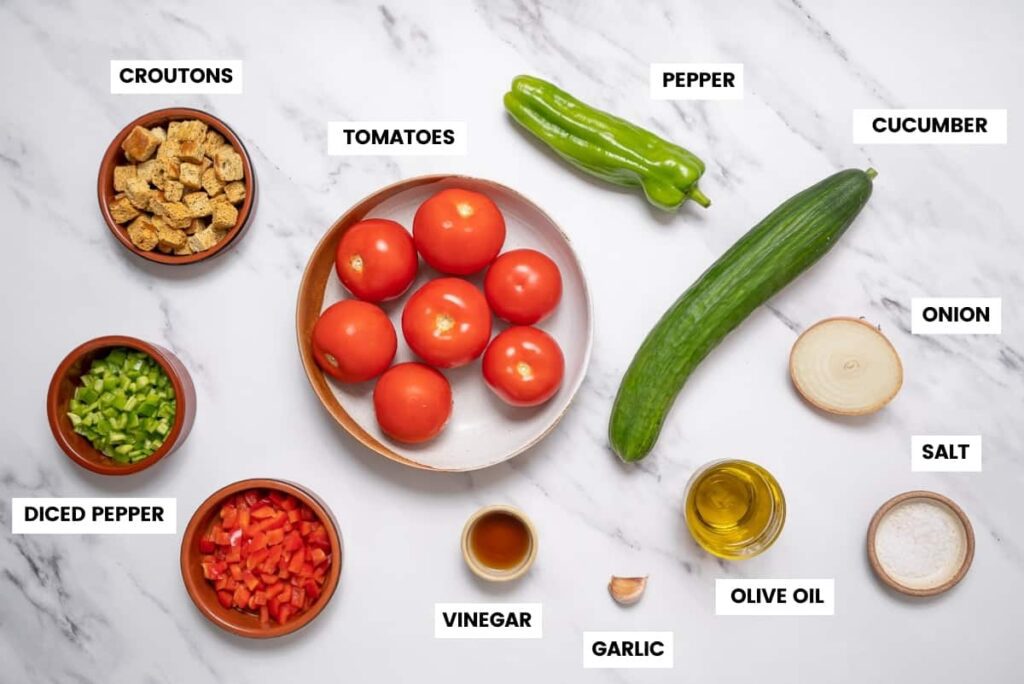When the scorching summer sun hits Andalusia, there is only one true culinary remedy: the refreshing and vibrant Gazpacho Andaluz. This traditional Spanish cold soup is far more than a dish; it is the beating heart of the [Andalusian lifestyle, where fresh seasonal produce, high-quality olive oil, and Mediterranean traditions converge]. Known for its intense, savory flavor, striking red color, and velvety smooth texture, Gazpacho has rightfully earned its place as one of Spain’s most celebrated and essential recipes.
Table of Contents
Toggle📜 History of Gazpacho
The origins of Gazpacho Andaluz date back to the rugged [Andalusian countryside, where it began as a survival meal] for farmers and laborers. Initially, they relied solely on simple, easily available ingredients like stale bread, garlic, olive oil, and vinegar to create a nourishing meal against the heat. This tradition was transformed fundamentally with the arrival of tomatoes and peppers from the New World in the 16th century, allowing gazpacho to evolve into the vibrant red soup we know and love today. Over time, it transitioned from a humble peasant dish to a revered cultural icon in Spanish cuisine, beloved across Spain and globally.
🍅 Key Ingredients of Gazpacho Andaluz

Authentic gazpacho relies on fresh, high-quality ingredients:
Tomatoes – the base, providing a sweet and tangy flavor. (Ideally, a ripe, vine-grown variety for deep color)
Cucumber – adds crisp freshness and a cooling effect.
Green pepper – for a mild, slightly bitter taste and complexity.
Onion & garlic – used judiciously to enhance aroma and depth.
Extra virgin olive oil – [essential for creaminess, flavor, and health benefits]. This quality oil defines the dish
Vinegar – usually sherry vinegar, for balance.
Bread – used traditionally to thicken the soup.
The result is a velvety, chilled soup bursting with Mediterranean flavors.
👨🍳 How to Prepare Gazpacho Andaluz ?
Preparing gazpacho is simple yet rewarding, focusing on achieving a perfectly smooth texture:
Wash and chop the vegetables.
Blend tomatoes, cucumber, pepper, onion, and garlic until completely smooth. For the best velvety texture, blend for at least three minutes.
Soak a small amount of stale country bread in water, squeeze out the excess, then add it along with olive oil, vinegar, and salt to thicken the soup.
Chill in the refrigerator for at least 2–3 hours.
Serve cold, garnished with diced vegetables or croutons.
Tip : The colder, the better. Authentic gazpacho is always served straight from the fridge.
💚 Health Benefits of Gazpacho
Gazpacho is more than delicious — it’s packed with nutrients:
Low in calories – perfect for a light summer meal.
Rich in vitamins A, C, and E – boosts immunity and skin health.
High in antioxidants – thanks to tomatoes and olive oil.
Vegan-friendly – suitable for plant-based diets.
This makes it both a tasty and healthy choice for anyone seeking a refreshing dish. You can find the freshest ingredients and highest quality olive oil at Barcelona’s [Local Markets – La Boqueria & Beyond].
🎭 Cultural Significance
In Andalusia, gazpacho is more than food; it’s an indispensable part of the culture and daily rhythm. Its history is rooted in the Andalusian countryside, representing the region’s ability to turn simple ingredients into a vital meal. Families enjoy it during summer lunches, serving it straight from the fridge as an immediate contrast to the scorching heat. Restaurants across Seville, Córdoba, and Granada proudly serve their own variations, reflecting the region’s love for fresh, local produce. This culinary tradition is deeply intertwined with the broader [Andalusian traditions, often enjoyed before attending a local Flamenco show].
📍 Where to Try Gazpacho in Spain
If you’re traveling through Andalusia, you’ll find gazpacho on almost every menu. Some of the best places to taste authentic versions include:
Seville – Find great traditional family-run tapas bars, particularly those near the Barrio Santa Cruz, Seville’s historic heart. You can also sample the freshest ingredients at the Mercado de Triana, one of Seville’s best local markets.
Córdoba – often served alongside salmorejo, a thicker cousin.
Granada – known for lighter, refreshing variations.
Gazpacho Andaluz is more than just a soup — it’s a culinary tradition that captures the essence of Andalusia …
❓ Frequently Asked Questions About Gazpacho Andaluz
🍅 What makes Gazpacho Andaluz different from other cold soups?
Gazpacho Andaluz is unique because it is entirely raw, made from ripe tomatoes, cucumbers, peppers, garlic, olive oil, vinegar, and bread. This gives it a naturally bright, refreshing flavor and a silky texture. It was traditionally created by Andalusian farmers to stay cool under the summer sun, and today it remains a symbol of southern Spanish cuisine. Its freshness, simplicity, and balance make it stand out among all cold soups.
🥒 When is the best time to try Gazpacho in Andalusia?
The perfect season to enjoy Gazpacho is from June to September, when tomatoes reach their peak flavor. During summer, Andalusia serves Gazpacho everywhere: restaurants, tapas bars, markets, and even cafés. Locals often drink it chilled directly from a glass to stay refreshed during the hot afternoons.
🥣 Where can visitors taste authentic Gazpacho Andaluz?
Authentic Gazpacho can be found in traditional taverns and family-run restaurants across Seville, Córdoba, Málaga, and Cádiz. Tapas bars usually serve it as a starter or refreshing drink. For the most authentic version, try it in local markets like Mercado de Triana or Mercado Central, where ingredients are freshest and flavors most vibrant.
🌿 Are there variations of Gazpacho across Spain?
Yes, Spain has several variations: • Salmorejo (Córdoba): thicker and creamier. • Ajoblanco (Málaga): almond-based white gazpacho. • Extremadura versions: sometimes include grapes or melon. These variations reflect local ingredients, but all share the same refreshing essence of cold Spanish soups.
🫒 Is Gazpacho healthy for visitors who want a light meal?
Absolutely. Gazpacho is low in calories, rich in vitamins, full of antioxidants, and perfect for hydration during warm days. Its Mediterranean ingredients — tomatoes, olive oil, garlic, cucumber — support digestion, provide energy, and help you feel refreshed without feeling heavy. Many locals drink it as a healthy snack or light meal.
📍 Can visitors find all the ingredients easily in Spanish markets?
Yes, Andalusian markets are full of fresh, high-quality ingredients ideal for making Gazpacho. Popular markets like La Boqueria, Mercado de Triana, and Mercado Victoria offer ripe tomatoes, peppers, cucumbers, garlic, and excellent Andalusian olive oil. Some vendors even prepare ready-to-drink Gazpacho so visitors can taste the authentic flavor on the spot.
Created by Spanaly
✍️ Gazpacho Andaluz is far more than just a soup; it is the refreshing, beating heart of the Andalusian summer. It is a culinary tradition that captures the essence of simplicity and flavor, leaving you with a cool, vibrant taste of southern Spain. Whether you prepare this authentic recipe at home or seek out a chilled glass in a local Seville bar, gazpacho is a must-try dish. It truly reflects the generosity and vibrant spirit of the region. For a complete guide to experiencing the region’s culture, food, and history, start with our ultimate guide to [Explore Seville’s Highlights]. In every chilled sip, you taste history, tradition, and the unmistakable warmth of the Mediterranean sun.



[…] Gazpacho Andaluz: Spanish Cold Soup […]
[…] you think of Spanish cuisine, few dishes are as iconic and comforting as the Tortilla Española — also known as the Spanish […]